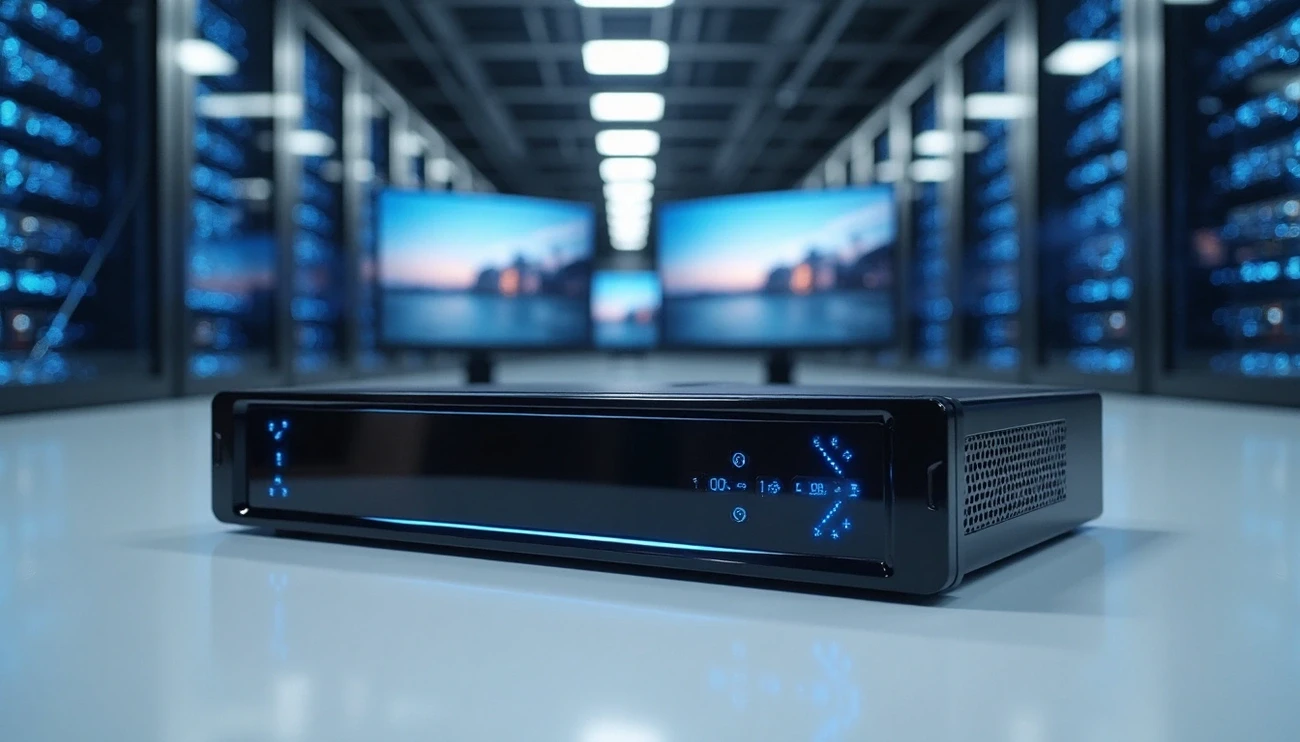Breaking: Next-Gen IPTV Encoder Doubles Video Quality at Half Bandwidth
Table of Contents

IPTV encoder technology has just reached a remarkable milestone that challenges longstanding streaming limitations. Revolutionary new encoding hardware now delivers twice the video quality while consuming only half the bandwidth of previous generation encoders. This breakthrough represents the most significant advancement in streaming technology within the past five years.
Previously, broadcasters and streaming providers faced an unavoidable tradeoff between video quality and bandwidth requirements. However, this next-generation IPTV encoder eliminates that compromise through sophisticated compression algorithms and redesigned hardware architecture. Furthermore, the technology maintains compatibility with existing infrastructure, making implementation surprisingly straightforward for organizations of all sizes.
Throughout this article, we’ll examine the technical innovations behind this encoder, explore its practical setup process, analyze real-world bandwidth savings, and review the enhanced security features that make it particularly valuable for enterprise applications. Above all, we’ll demonstrate why this development represents a genuine paradigm shift for the streaming industry.
Next-gen encoder delivers 2x video quality with half the bandwidth
The revolutionary shift in IPTV Encoder technology stems from fundamental changes in both hardware architecture and compression algorithms. This dual advancement enables the encoder to process video signals more efficiently than ever before.
What makes this encoder different from previous models
The next-generation IPTV encoder distinguishes itself through its software-based architecture, which offers several critical advantages over traditional hardware encoders. Unlike fixed hardware solutions, software encoders provide faster-than-real-time encoding capabilities, creating finished outputs at accelerated speeds 1. Additionally, these new encoders utilize Network Adaptive Encoding (NAE) technology, which dynamically adjusts compression levels in real-time when detecting network condition changes .
Scalability represents another fundamental improvement. These encoders can rapidly scale on generic IT hardware using Ethernet for inputs and outputs, eliminating the need for significant capital expenditure on specialized SDI routing equipment . Consequently, the redundancy model shifts from expensive fully duplicated environments to more cost-effective solutions where encoding capabilities can “float” between generic servers . IPTV Encoder
The software-based approach also enables “one-in, many-out” functionality, allowing a single input to simultaneously create multiple output formats—particularly valuable for environments requiring SD, 720p, and 1080i versions of each asset .
How compression algorithms have evolved
Compression technology has progressed significantly from H.264 (AVC) to H.265 (HEVC) and now to more advanced algorithms. The H.265 standard, finalized in 2013, introduced several critical advancements over its predecessor, including:
- Coding Tree Units (CTUs): Instead of small blocks, HEVC uses larger blocks up to 64×64 pixels, improving compression efficiency especially for high-resolution videos
- Advanced Motion Prediction: Enhanced motion tracking with more precise methods and multiple reference frames
- More Prediction Modes: A broader range of prediction techniques for better handling different parts of a frame
- Improved Entropy Coding: An advanced version of CABAC offering better compression
The newest AV1 codec aims to surpass even HEVC performance through block-based and tile-based coding that handles blocks from 4×4 to 128×128 pixels, adaptive quantization, and multi-layered entropy coding .
Comparison with traditional H.264 and H.265 encoders
The performance difference between traditional and next-generation encoders is substantial. HEVC/H.265 offers nearly twice the bandwidth efficiency of H.264/AVC . In practical terms, this means:
| Resolution | H.264/AVC Bandwidth | H.265/HEVC Bandwidth |
|---|---|---|
| 480p | 1.5 Mbps | 0.75 Mbps |
| 720p | 3 Mbps | 1.5 Mbps |
| 1080p | 6 Mbps | 3 Mbps |
| 4K | 32 Mbps | 15 Mbps |
IPTV Encoder
Studies from Moscow State University demonstrate that high-quality H.264 encoders can cut necessary bit rates by as much as half without reducing quality through better compression techniques . These improvements are achieved through methods like “lookahead,” which pre-analyzes frames to optimize bit allocation .
Quality comparison tests show that with equivalent image quality compared to H.264, H.265 encoded video size reduces by approximately 39%-44% . Even more impressive, when bit rates drop by 51%-74%, H.265 encoded video maintains equal or better quality than H.264 encoded content .
For streaming providers, these advancements translate to significant cost savings, extended service reach, and improved viewer experience—all critical factors in today’s competitive streaming landscape.
Engineers redesign hardware to optimize signal processing
Behind the scenes of next-generation IPTV Encoder lies a complete redesign of hardware components that fundamentally changes how video signals are processed. These engineering innovations enable the dramatic improvements in efficiency and quality that define modern streaming technology.
New chipsets and architecture improvements
The internal architecture of modern IPTV Encoder consists of multiple specialized components working in concert. A typical configuration includes an HDMI receiver chip that handles signal detection and EDID management, a dedicated video processing unit for scaling and format conversion, hardware encoder chips for compression, an audio processor for sound extraction, and a network interface for managing streaming protocols .
Unlike previous generations, these encoders feature dedicated processing chips specifically designed to handle HDMI’s timing requirements. This specialized architecture ensures minimal latency and maximum signal integrity throughout the encoding process . Moreover, some units can ingest up to eight distinct video inputs simultaneously in a single device, then stream multi-format broadcasts in real-time at various bit rates .
Hardware scalers represent another significant advancement, with dual hardware scalers accepting content up to 1080p, including both 60/30 Hz and PAL formats . Accordingly, these scalers can deliver programs at either scaled or native resolution, providing flexibility for different output requirements.
Thermal management and power efficiency
Processing 4K video creates substantial heat, requiring 4-8 times more processing power than 1080p content . Therefore, next-generation encoders incorporate advanced thermal management systems to maintain optimal performance. These systems typically include performance scaling mechanisms that can reduce encoding quality during high-temperature conditions and environmental monitoring tools that track ambient temperature and humidity .
Fan cooling with adjustable speed represents a common solution, balancing noise concerns with cooling needs . Notably, these cooling systems support the encoders’ ability to operate continuously in 24/7 broadcast environments without failure.
Power efficiency has likewise become a priority in encoder design. Many units now meet strict RoHS safety and California energy standards . The MGW Diamond encoder exemplifies this trend with its compact, power-efficient design that makes it ideal for applications with stringent size, weight, and power requirements .

Impact on latency and real-time streaming
Perhaps the most crucial advancement in hardware design is the dramatic reduction in latency. Hardware encoders now offer superior processing power compared to software alternatives, enabling higher quality video at lower bandwidth rates with reduced delay . In fact, some encoders achieve super ultra-low latency of less than 200 milliseconds from HDMI input to screen display . IPTV Encoder
Real-time processing capabilities have similarly improved, with some encoders maintaining guaranteed audio and video synchronization—a critical factor for broadcast networks and applications that cannot afford downtime . Additionally, reliability features such as adaptive bitrate encoding, packet loss recovery through protocols like SRT, and hitless failover over redundant networks ensure continuous streaming even under challenging network conditions .
These hardware improvements collectively enable the encoder to serve high traffic demands while maintaining exceptional video quality . Combined with the compression algorithm advancements, they form the foundation of next-generation IPTV encoding technology’s remarkable performance.
Setup process simplifies integration for broadcasters
The next-generation IPTV encoder transforms the typically complex integration process into a streamlined experience for broadcasters of all sizes. The simplified setup and configuration approach eliminates many traditional barriers to adoption, making advanced streaming technology accessible even to organizations with limited technical resources.
Plug-and-play installation steps
Initial hardware installation follows a straightforward process that minimizes downtime and technical complications. Most modern IPTV encoders support plug-and-play functionality with no driver installation required . The typical setup procedure involves:
- Powering off all devices before beginning the installation
- Connecting the HDMI source to the encoder’s input
- Attaching a display to the encoder’s HDMI output for monitoring (if available)
- Connecting the encoder’s RJ45 port to the network router
- Adding any optional RS232 connections for control systems
- Connecting power and turning on the devices
- IPTV Encoder
The reset button provides a convenient fail-safe, allowing users to re-detect displays if connection issues occur . Throughout the physical setup process, users benefit from clear connection points and standardized interfaces that minimize the risk of incorrect installation.
Web GUI and remote configuration
Beyond physical connections, modern IPTV Encoder feature user-friendly web browser-based graphical interfaces that simplify management and configuration. These interfaces provide complete control over encoding settings, audio parameters, on-screen display options, and system configuration .
Initially, users connect their computer directly to the encoder’s RJ45 port for basic setup. By typing the device’s default IP address (typically 192.168.1.168) into any web browser, administrators can access the configuration panel after entering standard login credentials . Following this basic setup, the encoder can be disconnected from the configuration PC and connected to an internet modem/router for normal operation .
Remote management capabilities represent a major advancement, with many units supporting complete configuration from anywhere on the network or even across the internet. This feature enables centralized management of multiple encoders across different locations . Additionally, IGMP protocol configuration on network switches ensures proper multicast traffic management essential for large-scale deployments .
Compatibility with existing IPTV infrastructure
The next-generation encoder’s design prioritizes seamless integration with established broadcasting systems. Most units support both multicast and unicast streaming protocols, allowing broadcasters to serve LAN and WAN customers concurrently . This dual-protocol approach eliminates the need for separate systems to address different network environments.
Regarding middleware integration, advanced encoders include API interfaces that connect to remote middleware or billing servers. These interfaces enable the transmission of billing information before and after each channel access through simple HTTP requests . Many systems also offer direct compatibility with streaming platforms like YouTube and Facebook through protocols such as RTMP, RTSP, HLS, RTP, and UDP .
Despite their advanced capabilities, these IPTV Encoder maintain backward compatibility with existing IPTV infrastructure. They can be deployed alongside current systems without requiring wholesale replacement of network equipment . Essentially, they function as modular components that enhance rather than disrupt established workflows, allowing broadcasters to upgrade incrementally rather than through costly system-wide overhauls.

Streaming platforms benefit from reduced bandwidth load IPTV Encoder
Next-generation IPTV Encoder deliver substantial bandwidth savings for streaming platforms through multiple protocol support and advanced compression techniques. These improvements enable services to maintain high-quality streams while dramatically reducing infrastructure costs and expanding reach to audiences with limited connectivity.
How the encoder supports RTMP, RTSP, and HLS
Modern IPTV encoder support a comprehensive range of streaming protocols that provide flexibility for different distribution scenarios. Most units support RTMP (Real Time Messaging Protocol) for direct streaming to platforms like YouTube, Facebook, and Twitch . Alongside RTMP, the encoders handle RTSP (Real Time Streaming Protocol), HLS (HTTP Live Streaming), UDP/RTP (User Datagram Protocol/Real-time Transport Protocol), and multicast/unicast delivery .
This protocol versatility allows broadcasters to simultaneously serve multiple platforms with optimized streams. High-end encoders can output up to four video streams concurrently, enabling simultaneous distribution to different platforms without additional hardware . For instance, using HLS protocol syntax (http://192.168.1.137:8090/stream1.m4u8), streaming providers can deliver content directly to smart TVs, IP boxes, mobile devices, and computers .
Bandwidth savings for cloud-based streaming
The bandwidth reduction capabilities represent perhaps the most significant advantage for cloud-based streaming operations. With CBR (Constant Bitrate) and VBR (Variable Bitrate) encoding options, operators can fine-tune their streams for optimal quality-to-bandwidth ratio . Some encoders achieve encoding rates from 32Kbps up to 32Mbps, providing flexibility based on content requirements .
For cloud services, the AWS Elemental MediaConvert bandwidth reduction filter can decrease encoded video bitrates by an average of 7% while maintaining visual fidelity . This reduction translates to substantial cost savings, as a 1 Mbps bandwidth reduction represents 45 TB saved for 60 minutes of content watched by 100,000 viewers . Subsequently, these savings offset the higher processing costs associated with advanced encoding techniques.
Case study: Streaming 1080p at 2Mbps
Perhaps the most compelling demonstration of the encoder’s efficiency is its ability to deliver full HD 1080p video at remarkably low bitrates. The HDMI video H.264 & H.265 IPTV encoder supports full HD 1080p resolution at 60Hz while minimizing bandwidth consumption .
Through H.264 encoding, operators can stream 1080p video at approximately 2Mbps—half the bandwidth traditionally required for comparable quality . As a result, what previously demanded 4-6Mbps can now be delivered at 2Mbps without visible quality degradation. This capability is particularly valuable for reaching audiences with bandwidth constraints or reducing CDN costs for large-scale deployments.
The efficiency gain stems from advanced rate control modes, with CBR/VBR rate options ranging from 1Mbps to 13Mbps depending on content complexity 21. Hence, streaming platforms can optimize their delivery strategy based on content type, audience size, and network conditions.
Security and control features enhance enterprise use
Enterprise security stands as a cornerstone feature in next-generation IPTV encoders, addressing critical concerns for organizations handling sensitive content. Enhanced protection mechanisms safeguard media assets while providing administrators with precise control over system access and operations.
Password protection and user access control
IPTV Encoder come equipped with multi-layered security systems starting with basic password protection. Default credentials (admin/admin) can be modified through the web GUI to establish proper authentication barriers . More sophisticated enterprise solutions offer comprehensive user management engines with visual topology views of networks, domains, and organizational units .
Military-grade access control systems employ drag-and-drop interfaces for assigning specific live video streams or recorded content to individual users or groups . This eliminates the need for complex routing filters or network access lists. In particular, systems with Active Directory integration establish the encoder as a secured network resource, enabling administrators to visually select which domain groups can access specific content .
Furthermore, administrators can selectively enable or disable playback and recording capabilities for designated users, creating customized permission profiles . Usage analytics track all user-initiated actions and content consumption patterns, offering valuable data about viewing trends and network utilization .
RS232 passthrough and remote diagnostics
RS232 connectivity serves dual purposes: system control and diagnostics. This interface supports both Encoder-to-Computer and Encoder-to-Encoder serial communication . Yet this functionality remains limited to local networks without internet accessibility .
For diagnostic operations, technicians connect using software utilities that manage communication at standard baud rates (typically 115200bps) . During setup, source and target port information must be correctly specified to establish proper communication channels .
Firmware update capabilities
Firmware management represents a critical security component. Many systems receive automatic updates when network-connected, ensuring devices maintain current security patches . Update notifications appear on management dashboards when new firmware becomes available .
Manual update processes involve uploading signed firmware packages through web interfaces . Prior to installation, these packages undergo verification to confirm digital signatures and prevent unauthorized code execution . Once verified, the system reboots to complete the update process .
Strategic update scheduling prevents broadcast interruptions, with systems typically waiting until after scheduled broadcasts unless updates address critical security vulnerabilities . IPTV Encoder
Conclusion
This revolutionary IPTV encoder marks a significant turning point in streaming technology, finally breaking through long-established barriers between quality and bandwidth consumption. Throughout the industry, streaming providers now face an unprecedented opportunity to deliver superior viewing experiences while simultaneously reducing infrastructure costs. The dual advancement in compression algorithms and hardware architecture has created a solution that maintains full backward compatibility with existing systems, therefore enabling gradual implementation without disruptive overhauls. IPTV Encoder
Undoubtedly, the technical innovations driving this breakthrough deserve attention. The shift from hardware-dependent to software-based architecture allows for faster-than-real-time encoding and dynamic compression adjustments through Network Adaptive Encoding. Advanced compression techniques built upon H.265/HEVC foundations deliver remarkable efficiency gains, essentially cutting bandwidth requirements by half while maintaining or improving visual quality. IPTV Encoder
The hardware redesign likewise plays a crucial role in this achievement. Specialized processing chips, dedicated video units, and sophisticated thermal management systems work together to handle complex encoding tasks with minimal latency. These components enable super ultra-low latency of under 200 milliseconds while ensuring reliable 24/7 operation even under demanding conditions. IPTV Encoder
Streaming platforms stand to gain substantial benefits from these advancements. The ability to deliver 1080p video at approximately 2Mbps instead of the traditional 4-6Mbps translates directly to cost savings and expanded audience reach. Additionally, multi-protocol support ensures content can simultaneously reach diverse platforms and devices without requiring additional hardware. IPTV Encoder
Perhaps most importantly, this technology arrives with enterprise-ready security features and straightforward implementation pathways. Password protection, user access controls, and RS232 diagnostic capabilities address critical security concerns for organizations handling sensitive content. Meanwhile, the plug-and-play installation process and intuitive web interface remove traditional barriers to adoption. IPTV Encoder
The next generation of IPTV encoders thus represents far more than incremental improvement—it fundamentally changes what’s possible in video streaming. Broadcasters, content providers, and enterprise users can now deliver exceptional viewing experiences without sacrificing efficiency or affordability. This technology ultimately establishes a new standard that will shape streaming innovation for years to come.
IPTV Encoder

